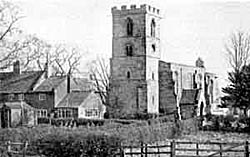< Previous | Contents | Next >
Lambley Church
 |
LAMBLEY with the name "Dumbles" conjures up in most people’s minds memories of Cowslip Sunday and other rustic delights. But there are other interests in Lambley besides these purely rural pleasures ; this quiet and rather remote village gave birth to one of the greatest statesmen and patrons of art during the middle ages.
In the year 1394, ten years after the death of Wycliff, there was born to the Lord of Lambley a son who was christened Radulphus, and who lived to become the great Lord Cromwell, Treasurer of England, and builder of many beautiful buildings, including Tattershall Castle and Wingfield Manor.
Probably the future lord was born in the old manor house of Lambley which stood where the present rectory is erected, and of which all that remains is a few depressions and hillocks in the adjoining field.
In his youth Cromwell inherited a small fortune, to which he added by the fruits of his service in the army invading France. He lived in stirring times and saw the deposition of Richard II., and the succession of the Lancastrian Henry IV., and took a large share in the invasion of France under Henry V.
He was appointed Chamberlain, and won much respect "on account of his wisdom and especially with regard to his moneymaking craft." In 1433 (two years after the death of Joan of Arc) he was made Lord Treasurer, an office which he held for ten years.
Cromwell’s greatest architectural work is elsewhere, but he always had a tender spot in his heart for Lambley, his birthplace, and by a codicil to his will directed that Lambley Church should be rebuilt at the expense of his estate.
The church is an interesting building set up in that style of architecture which is known as Perpendicular, and which came into fashion immediately after the Black Death. It contains a beautiful screen of the same date as the church, and some fragments of ancient glass are preserved in the windows, while the Lord Treasurer’s badge, representing money bags, may be seen here and there about the building.
One point more, Lord Treasurer Cromwell should never be confused with Oliver Cromwell, who lived a couple of hundred years after the Treasurer’s death, nor with Thomas Cromwell, Henry VIII.’s unpleasant minister.
